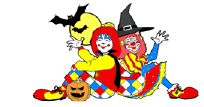 Face painting is one of the easiest, most inexpensive activities available. That's why it's so common at carnivals, fairs, parties, fund raisers and other celebrations. Kids love the fantastical designs they can get, from a simple heart, star, or balloon on the cheek to a full-face lion, fairy, butterfly, or soldier. Parents love that it doesn't cost much, is easy to get clean, and makes the kids happy.
So, if it's your job to apply face paint at one of these events, where do you begin? The technique will vary with the design, of course, but there are some general guidelines to painting faces that will hold true no matter what your design. :
Choose a handful of designs and practice them - If you're not a professional artist (and most face painters are simply volunteers manning a booth at a community event), don't attempt anything too complex. Some simple designs such as hearts, stars, balloons, butterflies, dogs, cats, masks, or popular cartoon or comic book characters will take a novice face painter far in her face painting task.
Cover large areas with sponges - A full-face butterfly, camo soldier, animal or super hero such as Spider-Man will require a lot of one or two colors, and it would take forever to try to cover that much skin with a slender brush. Use makeup sponges, which allow for wide strokes and control over the amount applied.
Use brushes for details - Brushes are ideal for lines, such as those outlining a design, highlights, which are usually done in white and add depth and realism to the design, and details such as eyes, patterns, stripes, dots, or other accents that make a design look so delightful.
Use crayons for easy designs - Face painting crayons are an easy way to draw simple designs, or to add bold lines or outline a design. They are inexpensive and feel natural in a beginner's hand.
Be flexible - Sometimes a kid has a definite idea what they want and it's not something you've practiced! Don't be afraid to give it a shot; you might be better at it than you think. But make sure your young client knows that you can't promise perfection because it's your first time! You can always wipe the attempt off and start over with something else.
Only use face paint - Facial skin is very sensitive, and that's especially true for children. Never use tempera, acrylic, or craft paint for painting faces. These items can provoke bad reactions on the skin. Make sure to acquire good face paints, such as Snazaroo, Kryolan, or Wolfe. These are available at some craft stores or online.
Face painting is a fun, easy, and inexpensive activity that can keep large groups of children entertained and happy. Using the basic techniques outlined above, you can have a successful event and a crowd full of delighted kids.
|
